The OX2K expedition
Origins
The idea of a full-scale VHF/UHF expedition to Greenland came back in 1988, when OX3LX/OZ1DJJ, Bo and OZ1FDH, Claus were sitting on a mountain top in southern Greenland with a home-made plywood 4CX250 PA for 144 MHz and a Mutek 50 MHz transverter. All the equipment was hand-carried more than 10 km, and the results back then were a few openings on 50 MHz and a single EME QSO on 144 MHz. More than ten years would pass before the dream of a full-scale expedition was to come true, and the largest effort was not the expedition itself, but rather all the planning and practical preparations that are required for a expedition covering 1.8 to 1296 MHz.
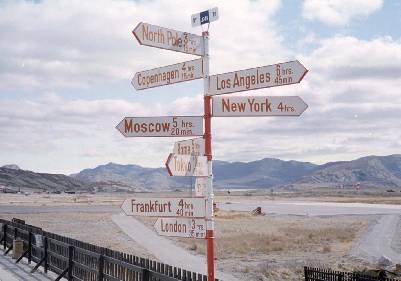 Traffic
signs at the airport. Soendre Stroemfjord is just about in the middle of
everywhere.
Traffic
signs at the airport. Soendre Stroemfjord is just about in the middle of
everywhere.
The first task was of course to find a location for the expedition, and a major concern in order to keep costs down was the transportation. As several tons of equipment were needed it was necessary to pick a location close to or at one of the two main airfields in Greenland. After a bit of searching OX3LX found that the conditions at Soendre Stroemfjord, or Kangerlussuaq as it is called in Greenlandic, 100 km north of the arctic circle were almost ideal. Soendre Stroemfjord is located at the bottom of a more than 120 km long fjord, and the favourable weather conditions have made it the main hub for incoming and outgoing traffic from Greenland. The airstrip was build by the US during World War II, and it served as a fuelling stop for planes going from NA to Europe. During the cold war Soendre Stroemfjord hosted a military base, submarine communications and relay stations for the US missile radar surveillance, which is why the surrounding mountains are loaded with radio installations. Most of these installations were abandoned, which meant that masts, cables, power and huts were available with minor modifications. With the help of OX3HI, Holger we got access to a mountain site called Black Ridge a few kilometres from the airfield. However, it took OX3HI with the help of OX3DU, Per and OX3LG, Michael almost all winter to clean the radio hut and replace the 110 V AC installations with 208 V AC. Another main advantage was that the Stanford Ionosphere radar, using a 32 m parabolic dish located at Kellyville 13 km from Soendre Stroemfjord, could be made available for 1296 MHz EME, but that it is another story which will be told elsewhere.
The only real disadvantage of the site is that unless you can ship the equipment 12 months in advance, you will have to rely on air transportation as ice will be blocking access to the fjords, making on-time delivery almost impossible.
We had some discussions about whether or not Soendre Stroemfjord was too far north for making anything but a few marginal 50 MHz contacts, but the experience of the local amateurs was that the propagation from this area was some of the best in Greenland, and furthermore OX3LX had made the best DX on 50 MHz from the DYE-1 radar station less than 100 km away. Therefore we hoped for a little bit of luck, and if we got 10-25 QSOs in the log we would regard it as a success - little did we know, that reality was soon to exceed even our wildest expectations.
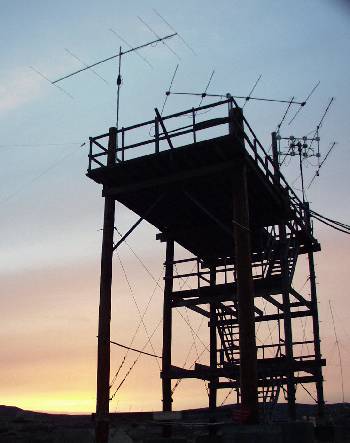 The
antenna platform at midnight with the 50 MHz and 432 MHz antennas
The
antenna platform at midnight with the 50 MHz and 432 MHz antennas
The winter of 1999/2000 came and 25 amateurs signed up for the expedition. We got our own callsign OX2K (this was actually the first time an OX2 prefix had been issued), and all the practical preparations were ongoing. We had most of the equipment needed but our PAs were not really prepared for a DXpedition, which is why OX3LG/OZ2ELA made an enormous effort re-fitting and building the VHF/UHF PAs.
On 50 MHz we would be using an FT-847 with a 4CX1500 feeding the antennas. We looked for a 2 wl antenna, but equipment and transportation costs made it necessary to settle for four and five-element 1 wl yagis. Unfortunately, just prior to the start of the expedition the Danish Air Force cancelled their flights to Soendre Stroemfjord, which meant that we would have to look for an alternative and expensive carrier for about 800 kg of equipment. Anyway all the practical problems were more or less solved, and we all waited eagerly for the expedition to start.
OX2K On the Air
The major part of the participants would arrive on May 29th which was the official start date, but OX3LG, OX3LX, OX3OX Ole and OZ1FDH would start preparing the site almost a full week before.
There was a lot of work to be done. Masts had to be erected, an almost endless amount of cables had to be connected, the equipment was unpacked and checked etc. Luckily enough, being that far north you have 24 hr daylight which is a big help when working outdoors. It was quite an experience assembling antennas at midnight with the sun still shining, while you were being watched by some of the local wild life: musk ox, arctic fox and deer. A nice feature about 50 MHz is that compared to 144 and 432 MHz EME stations, it is almost no effort to put up the equipment. In order to be QRV as soon as possible we put the 4 ele on the antenna platform and connected the FT-847 on May 26th - yes we were QRV!
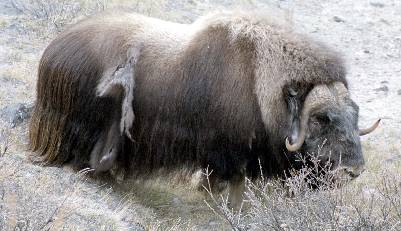 Local
wildlife. A musk ox checking out the radio site.
Local
wildlife. A musk ox checking out the radio site.
The first evening brought a few pings from NA and TF TV, but around 20 GMT the VE8BY beacon was 59+ which according to OX3LX was an almost everyday experience, and about an hour later the OH9SIX beacon was in for 20 min, but unfortunately no stations were QRV. Not a bad start: we had already heard the first amateur signals.
The next day (May 27th) the E-layer started warming up again around 20 GMT. We had set up a CQ loop on 110, suddenly there was somebody answering our call, and bingo! TF3FK was in the log. TV signals were now heard on 48.25 MHz and a little bit later G8BCG/P called, followed by seven more contacts to F and G stations before the band closed. The ice was broken and the propagation was there.
It had been discussed whether or not we should use 110 as our ‘beacon’ frequency, but being far away from the main centres of activity, calling on 110 gives you the highest chances that somebody may actually hear you if there is an opening.
May 28th brought a few more contacts with TF3FK, and more reception of OH9SIX and even GB3RMK around 01 GMT. There were lots of TV signals at 48.38, 48.25 and 48.26 MHz but no amateur stations were heard. To our big surprise the Concorde landed the same morning, filled with British tourists on a three-day trip to Greenland, and we thought that this was about as far away as you could get from the main traffic routes - let alone 50 MHz propagation. However, the next day the show started…
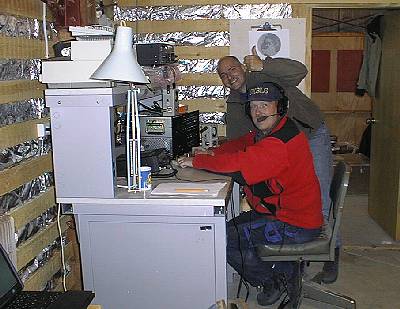 OX3LG
and OX3LX setting up the 4CX1500 PA for 50 MHz. It works 1kW+. Let's get work
some DX!
OX3LG
and OX3LX setting up the 4CX1500 PA for 50 MHz. It works 1kW+. Let's get work
some DX!
In the morning (May 29th) we set up the 50 MHz PA and were now heating up the E-layer with all the power we had. While OX3LX and OZ1FDH were working on the 144 MHz antennas, OX3OX shouted from the hut that there was somebody making noise on 110. We literary dropped the 144 MHz EME antenna and rushed to the station. It was only 12 GMT and the band was open! UK stations were calling us in numbers. Initially signals were very weak with lots of QSB, almost like EME. Another problem was that the old US power lines now and then would produce S 2-3 noise when beaming towards Europe, making it difficult for us to copy the weaker stations. The opening went on for about two hours and conditions improved giving us G, GD, GM, GI, GW, F, PA, I and 9H1XT (more than 5300 km!) in the log, a total of 60 QSOs. What a success: we had already passed our 25 QSO target!
Now the rest of the team arrived on the SAS plane from Copenhagen, and soon the site was like a beehive with amateurs swarming all over. We were now: OZ2Q, OZ1PIF, OZ1FDJ, OZ1CBW, OZ5RZ, OZ5ZF, OZ1BNN, OZ3SW, OZ1JSH, OZ2TG, OZ1FTU, PA5DD, PE5DD, OZ1FIT, OZ1FQ, OZ5IR, OZ7YK, OZ7FI, OZ1FDH, OX3LG, OX3LX, OX3OX, OX3DI and OX3HI. The magic band was graceful enough to give us a five-hour break in order to set up another antenna, meaning that we had a five-element rotatable and a four-element yagi fixed to Europe or NA. At 19 GMT the band exploded again. It started with only weak TV signals on 48.26 MHz but OH1AYQ answered our CQ followed by more OH, SM, LA, GM, GI, G, GJ, GU, ES, F and a single 5000 km+ QSO with AA5XE before it died around 23 GMT. Wow! This was to good to be true, we had now passed 120 QSOs. what would be next? OZ1FDH made a joke that going at this rate we would easily pass the 400 QSO mark before the expedition was over, but of course nobody believed it to be anything but a joke.
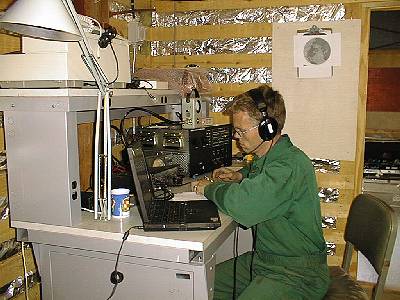 Concentrating
on those weak signals. OZ1FDH working CW on 50 MHz.
Concentrating
on those weak signals. OZ1FDH working CW on 50 MHz.
The next day, May 30th, brought a brief opening around 17 GMT logging three QSOs to PA, SP and DL, and then about two hours later the band literally exploded in our headsets. It started with OH2BC but soon PA, DL and SM stations were calling in numbers. We moved to 120 and started working split, and it was just tremendous. In one single pile up you could hear DL, PA, OE, OK, I, S, 9A, YU, OZ and LX stations calling you, and at one point we were up to working five QSOs a minute. This was one of the biggest thrills, you could ever experience as a radio amateur! The band died at 2330 GMT, and gave us a two-hour break for catching up on some food before it opened to NA. We had very strong signals from the eastern and middle part of NA and on the DX-cluster there were reports on VE9AA working KL7 which is why we were beaming 270-290 degrees hoping to reach KL7 as well. Unfortunately, apart from a VE5 station we heard no signals from the western part of NA. When it was all over in the early morning hours, we had reached 370 QSOs and more than 27 DXCCs were in the log. We did not receive any Ch2 Eu TV when the opening started, whereas somewhat into the opening the TV signals were 59+.
Interestingly, the signals from the W and VE stations had a typical auroral sound to them, whereas the signals from EU where far more clear. At one point during the NA opening we even started calling CQ on 144 MHz, and given the experience on 50 MHz anything appears to be possible from that location. Exhaustion was beginning to take its toll, as some of the VHF operators had been going for more than 48 hours without sleep, but still we managed to keep both the 50 MHz and the 144/432 MHz EME stations working.
June 1st brought a new opening around 20 GMT to southern Europe, giving lots of I, HB9, F, 9H1 and a single DL station in the log. At 23 GMT it opened again this time giving OX to 12 OZ and a single DL station. OZ1FDH had returned to OZ on May 31st and managed to work OX2K the next day - talk about being lucky! It appeared that anything was possible.
June 2nd and 3rd brought another few openings to ON, SM, LY and TF making a total of 448 QSOs and 32 DXCC of which 11 were OX firsts.
Conclusions
On evaluating the expedition it is fair to say that the result was far above what anyone had expected. We must have hit a good week, but there is a clear trend that propagation into the arctic on 50 MHz is far more frequent than has previously been assumed. The result is well in accordance with the experience of OX3LX, who has found that the beginning and the end of the Es season produce the highest number of openings from OX. Also it is interesting that the major part of the openings were to Europe rather than NA; considering the distances involved, propagation to NA should occur more often. The next question is then what mode(s) of propagation were responsible for all the good propagation. Given the distances between OX and Europe some type of double hop auroral-E/Es may have been involved. Could this be boosted by other factors e.g. a high SFI? Any feedback or input on this would be highly appreciated.
Some other experience is that transmitter power really helps spotting the openings at an early stage. Bring as much power as possible. The concept of having two independent antennas is really useful for spotting openings. As some of the signals on our side were quite weak, it would have helped if we have had 2-3 dB more antenna gain, but we probably got all out of the equipment we had.
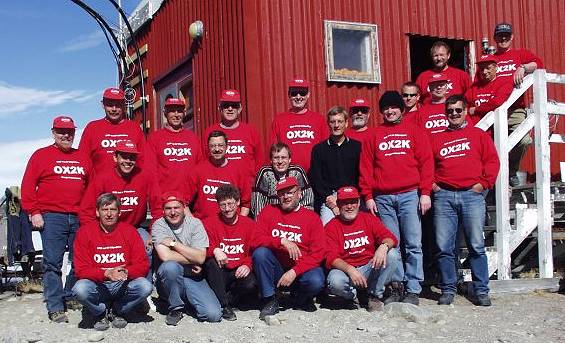
A happy team at the end of a successful expedition.
On the stairs: Holger,
OX3HI; Steen, OZ2TG; Michael, OX3LG.
Back: Benny, OZ5RZ; Jan, OZ5ZF, Ole, OX3OX; Peter, OZ1CBW, Jørgen, OZ1JSH,
Ivan, OZ5IR; Rune; Frank, OZ1FQ.
Middle: Knud, OZ1FIT; Frits, OZ2Q; Uffe, PA5DD; Søren, OZ1FTU; Bo,
OZ2M;Peter, OZ1PIF.
Front: Steen, OZ3SW; Bo, OX3LX; Jørgen, OZ1BNN, Kurt, OZ7YK; Ole, OZ7FI.
A very convenient feature was that we set up a microwave link giving us 24 hr on-line access to the DX summit and UKSMG web sites, which was extremely useful in spotting openings and reporting our activity. It was most likely helping us in the way that people knew we were on the band and they would actually wait for us. The impression was that we gave almost half of the European 50 MHz operators some sleepless nights, but it is fair to say that it paid off for a number of stations.
The total result of the expedition were more than 12000 QSOs of which 448 were on 50 MHz , 36 on 144 MHz, 37 on 432 MHz and 121 on 1296 MHz - a pretty good result!
We have left behind a fully-equipped radio hut, with all the cables, power and masts necessary for future expeditions. The 144 MHz yagis donated by Force 12 are of a very rigid and strong design capable of withstanding an arctic winter. They will be put up permanently on the site, so if you want to work 144 MHz EME all you need to bring is the PA and a transceiver.
Soendre Stroemfjord is easily accessible by air year-round for a reasonable price, and if anybody would like to go and get the OX-experience, it can be done with relatively little effort.
There is one thing about Soendre Stroemfjord and Greenland which makes it worth going there even if you bring the radio or not. It is simply one of the most fantastic places on earth. The scenery and the nature is breathtaking and almost beyond description. The air is so clear that you can pick out a single piece of rubble on a mountain top 10 km away. On top of that, it appears that you will find some excellent propagation, which is just one more reason to go there.
Finally we would like to thank al those who supported the expedition, especially the very gracious contribution from the UKSMG helps to keep the budget within reasonably limits. The only thing that remains is - where should we go next?
CU on Six from the OX2K team.
OZ1FDH Claus Felby, Skovvangsvej 17, 3670 Veksoe, Denmark